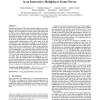Free Online Productivity Tools
i2Speak
i2Symbol
i2OCR
iTex2Img
iWeb2Print
iWeb2Shot
i2Type
iPdf2Split
iPdf2Merge
i2Bopomofo
i2Arabic
i2Style
i2Image
i2PDF
iLatex2Rtf
Sci2ools
PPOPP
2009
ACM
2009
ACM
Atomic quake: using transactional memory in an interactive multiplayer game server
Transactional Memory (TM) is being studied widely as a new technique for synchronizing concurrent accesses to shared memory data structures for use in multi-core systems. Much of the initial work on TM has been evaluated using microbenchmarks and application kernels; it is not clear whether conclusions drawn from these workloads will apply to larger systems. In this work we make the first attempt to develop a large, complex, application that uses TM for all of its synchronization. We describe how we have taken an existing parallel implementation of the Quake game server and restructured it to use transactions. In doing so we have encountered examples where transactions simplify the structure of the program. We have also encountered cases where using transactions occludes the structure of the existing code. Compared with existing TM benchmarks, our workload exhibits non-block-structured transactions within which there are I/O operations and system call invocations. There are long and s...
Non-block-structured Transactions | Parallel Computing | PPOPP 2009 | Quake Game Server | Shared Memory Data |
Related Content
| Added | 25 Nov 2009 |
| Updated | 25 Nov 2009 |
| Type | Conference |
| Year | 2009 |
| Where | PPOPP |
| Authors | Adrián Cristal, Eduard Ayguadé, Ferad Zyulkyarov, Mateo Valero, Osman S. Unsal, Tim Harris, Vladimir Gajinov |
Comments (0)

